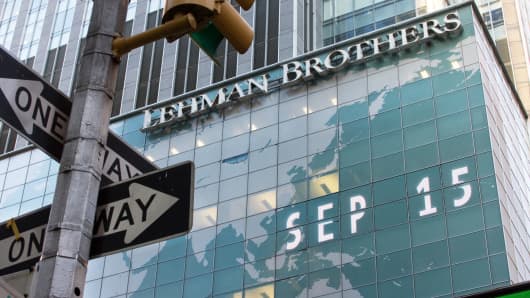Five years after Lehman Brothers collapsed and AIG got bailed out, regulators insist that the banking system is safer, taxpayers are protected from being asked to rescue Wall Street again, and the next panic will be more orderly.
Critics contend that the banks are bigger now, that the landmark Dodd-Frank financial reform act is an unfinished labyrinth of overly burdensome regulations and that "Too Big to Fail" remains a troubling reality of the financial system.
Who's right?
Here's a look at what's happened, what hasn't happened, and what it means for the next crisis.
A wider safety net
There's little debate that banks have more capital and greater liquidity, that is, they have a bigger cushion to ward off the next panic. Capital ratios for the nation's 18 biggest banks are up by $450 billion since 2008, according to the Treasury Department. The ratio of capital to assets is up to 12 percent on average from around 8 percent in 2008.
The Federal Reserve has also instituted, as mandated by Dodd-Frank, routine annual stress tests that limit how much a bank can spend on dividends and share buyback programs and test for whether a bank is capable of withstanding a severe financial shock. Under recent stress scenarios, the biggest banks would now have more capital than they had during good times before the crisis.
(Read more: Dodd-Frank turns 3, but slew of rules are still unwritten)
There's also little doubt that tougher financial regulations now cover more of the banking systems. Twelve new banks will be forced to undergo stress tests next year and two companies—AIG and General Electric Capital—will be subject to financial supervision similar to banks.
All of these big institutions are required now to maintain up-to-date living wills—a blueprint for unwinding the bank in the event of a crisis. This should help avoid the chaos of the Lehman weekend five years ago when regulators struggled to understand the dimension of the bank's complex derivative holdings and its ties to other financial firms.
'Title II' bankruptcy
Finally, inside Dodd-Frank is what one securities attorney calls "the single best part of the financial reform act." It's known as Title II, or in layman's terms, bankruptcy for banks. (Since it is not part of the bankruptcy law, it is technically inaccurate to call it bankruptcy or, as some put it, Chapter II bankruptcy. It's not.)
It's a step-by-step process that governs what happens the next time a big financial institution teeters and falls. It calls for management to be removed, the bank holding company to be place into receivership, its subsidiaries to be placed into a bridge company that is financed by the Federal Deposit Insurance Corp.
Stockholders would be wiped out and debt holders would bear losses. The FDIC would temporarily finance the bridge company but the law allows the government to turn to debt holders to recover any losses from a Title II resolution. If that is insufficient, it has the right to ask for repayment from the financial industry.
Regulators insist this should ensure that taxpayers are not put on the hook again.
(Read more: Big banks don't need to be split up: Sandy Weill)
Diverse critics
The criticisms of the new rules run the gamut from conservative to liberal, from those who believe the government has done either too much or too little, and those who believe the government has squarely addressed the wrong problems.
Those who think the government has done too much have two very different ideas: One group says the 13,000 pages of new rules (nearly 15 million words, according to Hamilton Place Strategies) overlay a costly regulatory burden on the financial industry that hampers its ability to provide credit for the economy to grow. They say it's a big reason for low economic growth right now.
(Read more: Was Lehman failure really 'best and only outcome?')
Yet another viewpoint comes from those who say the new rules have done too much to hamper government the next time there is a crisis. In other words, they argue that Dodd-Frank and other rules make a mistake by making it too difficult for the government to bail out a bank again.
For example, Dodd-Frank prohibits the Federal Reserve from using its emergency powers to bail out an individual bank as it did with AIG and Bear Stearns. It can still provide broad-based, industrywide support through its special authority, but it now requires approval of the Treasury secretary. Given the political fallout from the financial crisis, that approval is not assured.
Bigger hurdle for bailouts
Finally, separate legislation prohibits the use of the Economic Stabilization Fund to bail out financial institutions. The fund was used during the financial crisis to backstop the money market industry.





